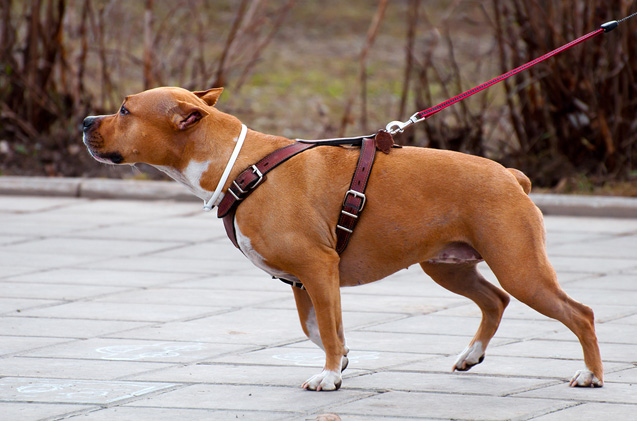I often get asked by clients whether they should walk their dog on a harness or a collar. From seeing literally 1000s of dogs walked on every conceivable harness and collar type, I can say with absolute certainty that there is no one answer for this!
The classic dog training principle is that you have more control of your dog if they are walked on the collar, and to a large degree it’s hard to argue with this. Having the lead tension on the neck does cause most dogs to be better behaved on a lead walk. You need a much more well-trained dog to be walked on a harness.
What also has to be considered though is the psychology of tension on the lead.
A classic example of this is an owner applying tension to the lead every time they see a dog, preparing themselves for their dog (non-aggressively to begin with) trying to get to the other dog. The owner sees this as a preventative measure. Your dog however interprets this as you being stressed by the dog, and will in turn start to associate the tension and your stress with the sight of other dogs. This often leads to your dog being stressed when they see dogs, and then becomes aggressive / displays reactive behaviour on the lead.
The above shows that where and when we apply tension to a dog on a lead can have a huge impact on their experience, which in turn can change their behaviour for the worse.
So, it’s important to know your dog and know where tension for them is best. I have seen some puppies have a complete meltdown when a collar and lead are attached, and in these cases you could cause psychological trauma long before the dog gets used to the set up – in these cases a harness is definitely best.
Seeing your dog on both set ups will allow you to decide what is best for your dog. You are looking for the right balance of obedience and relaxed behaviour.
You can also buy a double clipped lead, and attach your lead to both the collar and the harness, sharing the tension between both areas (this is a personal favourite of mine when working with dogs who pull a lot on the lead).
When your dog is a puppy, or if they are a small breed, it’s also important to remember how delicate their little neck is. If they are pulling constantly, or you need to pull them back in an emergency, you can harm them – I often recommend a harness on toy breeds for example as their necks are very delicate.
On the topic of collars, I would also like to quickly mention prong and pinch collars. These horrible devices are not illegal, used by some owners, and even recommended still by some trainers. The arguments for these devices are flawed and out dated.
These arguments include trainers wearing them and being pulled to show they don’t hurt (forgetting that humans have thicker skin on their necks than dogs, the human can tense their neck in preparation for the impact, and the human understands why the pain is being applied – a luxury a dog does not have).
Adverse training techniques should be a thing of the past, these collars included. Please read this RSPCA article, and this PETA article, on these collars for more information and to hear from the people who see the impact of these the most.

